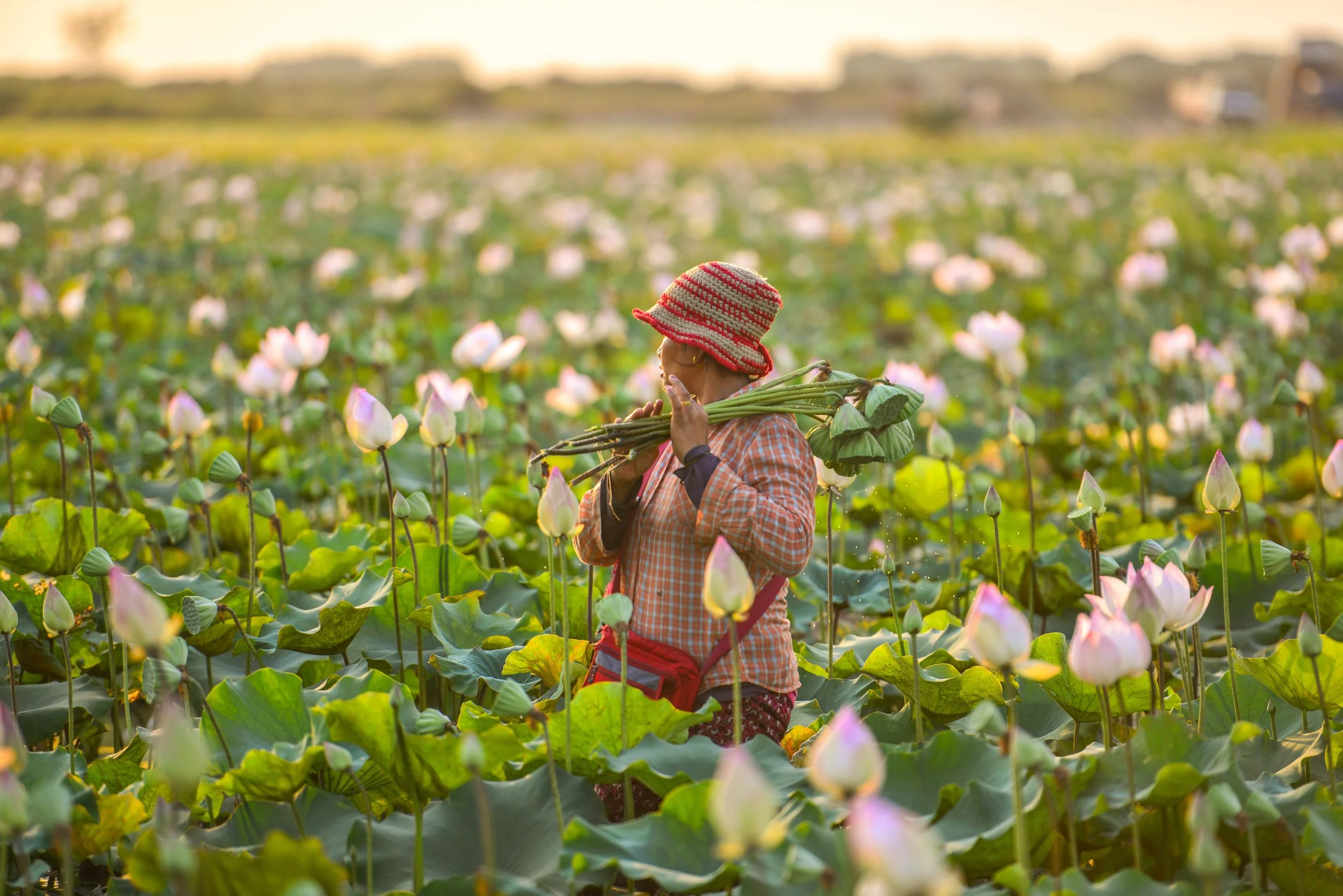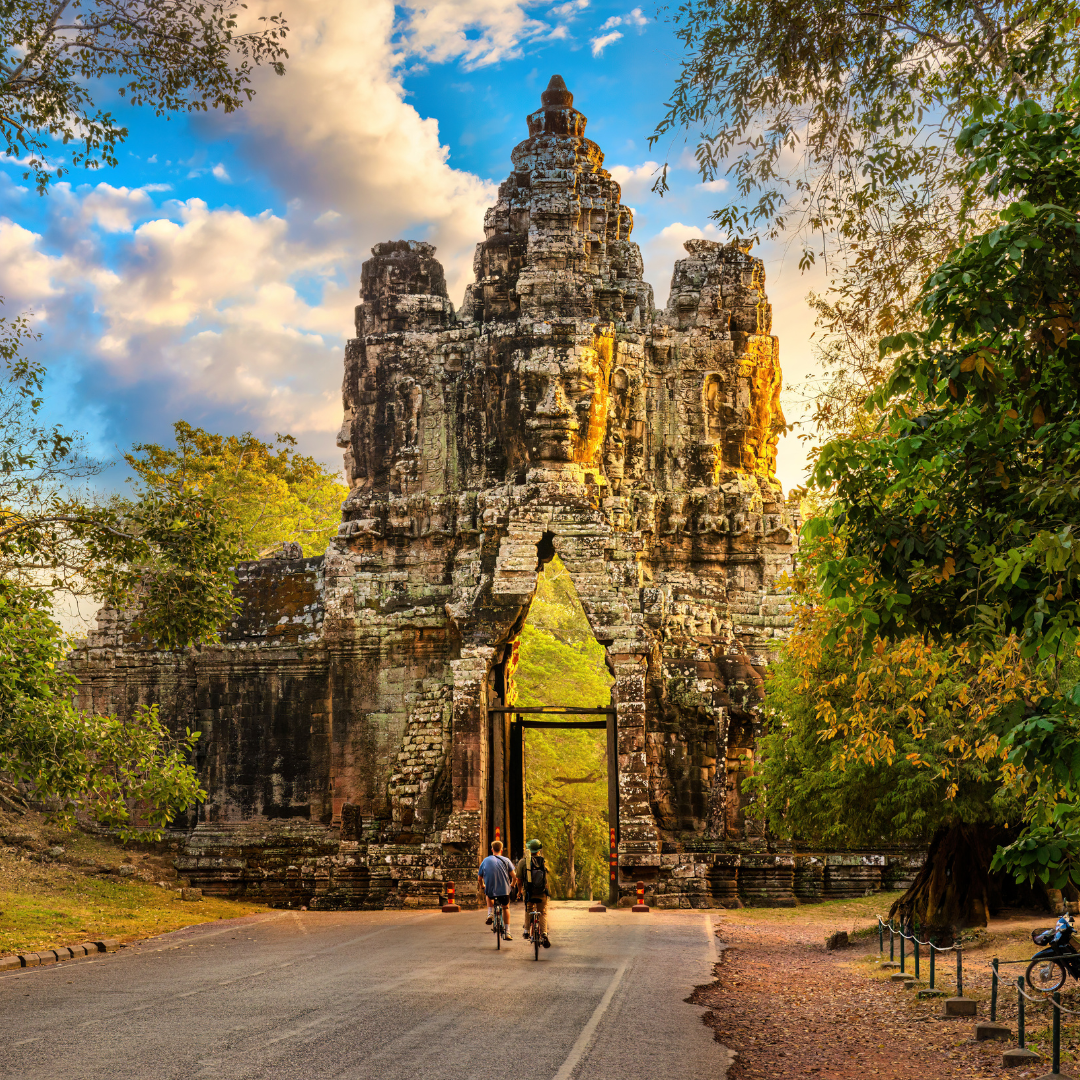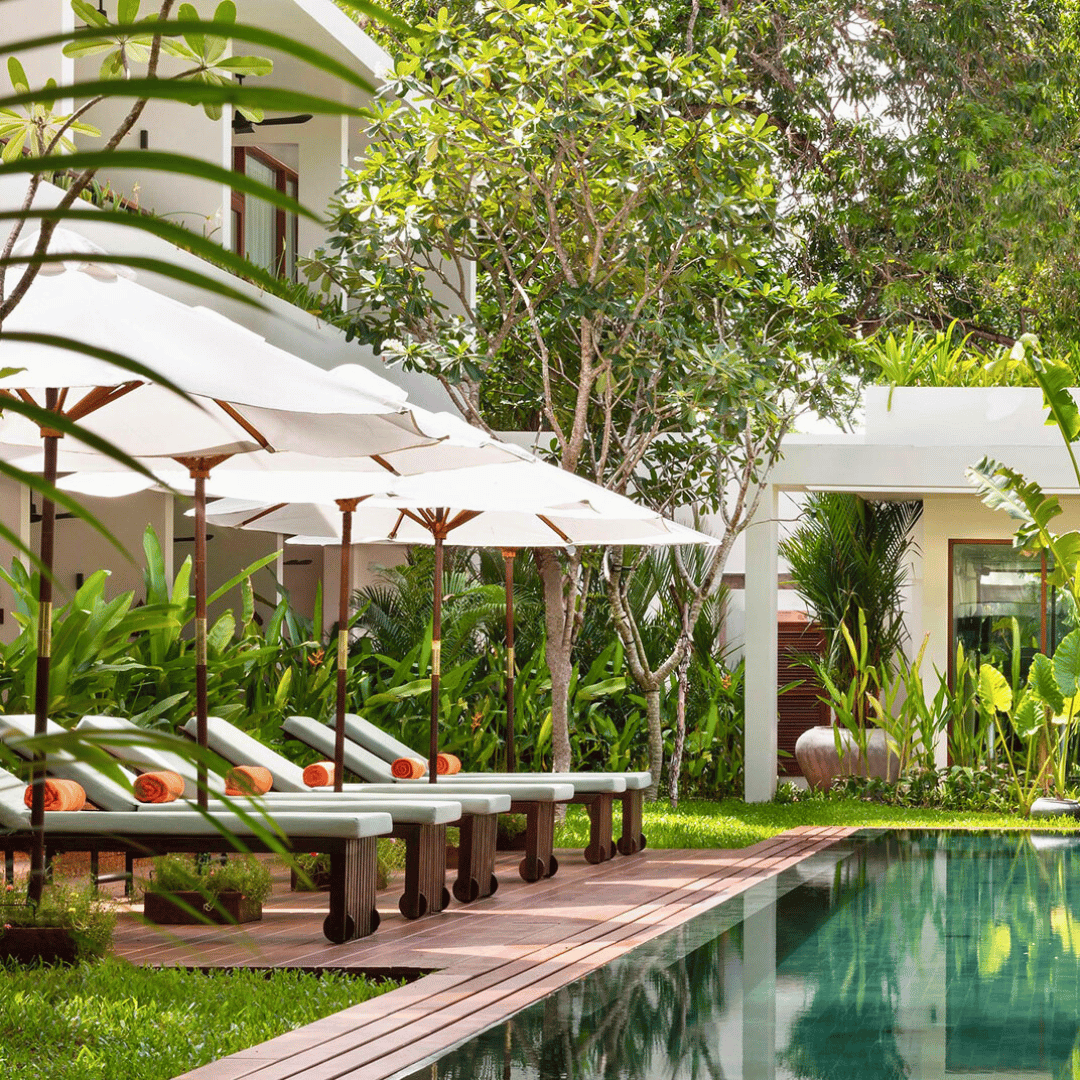
Cambodia Private Tour Packages
Bespoke Itineraries Designed For Australian Travellers
Cambodia is a country of ancient temples, vibrant cities, and enduring traditions, offering travellers a journey through South East Asia’s rich history and culture. At its heart lies Angkor, where the iconic Angkor Wat rises above the jungle, and where crumbling stone temples and hidden shrines reveal centuries of devotion. Phnom Penh blends royal palaces, bustling markets, and poignant reminders of the past, while the countryside offers timeless villages, rice fields, and floating communities on the Tonle Sap. Private tours of Cambodia can be tailored to balance cultural discovery with local encounters, whether that means exploring by bicycle, joining a cooking class, or cruising the Mekong at sunset.
Travellers may find themselves wandering temple corridors at dawn, chatting with artisans in their workshops, or discovering quiet pagodas far from the crowds. Whether your focus is on history, daily life, or the landscapes that connect them, Cambodia private tour packages offer an intimate and rewarding way to experience the depth and diversity of this remarkable country. At Asia Unbound, we design private journeys across Asia for Australian travellers seeking flexible, well planned experiences and genuine cultural connection.
Our Best Cambodia Tour Itineraries
Cambodia Travel Advice For First Time Visitors
-
Travelling to Cambodia is a memorable experience, and a little preparation ensures your trip runs smoothly. Most nationalities need a visa to enter, which is simple to arrange online as an e-Visa or upon arrival at international airports and certain land borders. Your passport should be valid for at least six months, and you may be asked to show proof of onward travel. Some travellers choose to arrange their visa in advance for peace of mind, especially during peak travel times.
Getting around Cambodia can be an adventure in itself. The main cities of Phnom Penh and Siem Reap are linked by short domestic flights, while buses, private cars, and boats connect towns and rural areas. Road travel between provinces is common, but journeys can take longer than expected due to traffic or road conditions. Hiring a private driver or joining a tour makes overland travel more comfortable and allows for spontaneous stops in villages or at local markets.
In terms of currency and payments, Cambodia officially uses the riel (KHR), but in practice, the US dollar is widely accepted and often preferred. Prices in shops, hotels, and restaurants are often quoted in dollars, while small change is given in riel. ATMs are common in cities and tourist centres, dispensing both currencies. Credit cards are increasingly accepted at hotels and larger establishments, though cash remains essential in rural areas, for small purchases, or when visiting community projects.
Health and safety are worth considering before departure. Medical care in Phnom Penh and Siem Reap is adequate for routine needs, but facilities outside these cities are basic. It is strongly recommended to have comprehensive travel insurance that covers medical treatment and emergency evacuation. Travellers should consult their doctor regarding recommended vaccinations, and carry sufficient supplies of any prescribed medication, as local pharmacies may not stock the same brands or dosages.
On a cultural level, Cambodia is a predominantly Buddhist country with a rich and resilient heritage. Visitors will encounter temples, shrines, and pagodas in both cities and villages. Respectful behaviour is appreciated—listening to your guide’s advice on local customs will ensure smooth interactions. Cambodia’s recent history, particularly the Khmer Rouge period, remains an important part of the national story. Sites such as Tuol Sleng Genocide Museum and the Killing Fields are moving to visit, and approaching them with sensitivity is encouraged.
Engaging with local communities is one of the highlights of travelling in Cambodia. Learning a few basic phrases in Khmer, supporting fair-trade crafts, or visiting responsibly managed cultural projects allows travellers to contribute positively to the local economy. Guides are often deeply knowledgeable and offer valuable insights into daily life, traditions, and contemporary issues.
In summary, prepare by arranging your visa, ensuring you have travel insurance, carrying both US dollars and some riel, and keeping an open, respectful attitude towards the culture and history of the country. Doing so not only helps your trip run smoothly but also creates a richer and more meaningful experience of Cambodia.
-
Cambodia doesn’t have “states” in the way some countries do. Instead, it is divided into 25 administrative provinces, known locally as khaet, plus the capital city Phnom Penh, which has a special municipality status.
Here’s the full list of Cambodia’s provinces and capital:
Phnom Penh (special municipality and capital)
Banteay Meanchey
Battambang
Kampong Cham
Kampong Chhnang
Kampong Speu
Kampong Thom
Kampot
Kandal
Kep
Koh Kong
Kratié (Kratie)
Mondulkiri
Oddar Meanchey
Pailin
Preah Vihear
Prey Veng
Pursat
Ratanakiri
Siem Reap
Preah Sihanouk (Sihanoukville)
Stung Treng
Svay Rieng
Takeo
Tboung Khmum
Each province has its own capital town, and many are known for unique cultural or natural attractions - for example, Siem Reap for Angkor Wat, Battambang for colonial heritage and countryside, Kampot for pepper farms and riverside charm, and Mondulkiri for its forests and elephant conservation projects.
-
The official language of Cambodia is Khmer, also known as Cambodian. It is part of the Mon-Khmer branch of the Austroasiatic family and has its own script, one of the oldest in South East Asia. Khmer is spoken by most of the population and is the language of government, education, and daily life.
Cambodia is also home to a number of minority languages. In the northeast, ethnic groups speak their own dialects such as Tampuan, Kreung, and Jarai. Vietnamese, Cham, Lao, and Chinese communities also contribute to the country’s linguistic diversity.
For visitors, English is the most practical second language. It is widely taught and commonly used in tourism, while French, a legacy of the colonial era, is still spoken in some circles, especially among the older generation.
Some useful Khmer phrases for travellers to Cambodia include:
Hello - Chum reap suor (formal) or Sous-dey (casual)
Goodbye - Chum reap lear (formal) or Lea hai (casual)
Please - Som
Thank you - Or-kun
Learning a few simple words in Khmer is greatly appreciated by locals and helps create warmer, more personal connections during your travels.
-
The most popular time to visit Cambodia is from November to March, when days are generally clear and warm. These months are ideal for exploring Angkor’s temples, cycling through Siem Reap’s countryside, or walking along Phnom Penh’s riverside boulevards. With rivers at steady levels, boat journeys on the Tonle Sap or Mekong are also rewarding. This is peak travel season, so you can expect more visitors at major sites, but also a lively and festive atmosphere.
By April and early May, the temperatures rise sharply, but this is also when Cambodia celebrates its most important holiday, Khmer New Year. The multi-day festival is filled with family gatherings, traditional games, and nationwide celebrations. Travelling during this time gives you the chance to witness local traditions and join in the fun, though it can be busy in towns and transport hubs. The coastal areas are particularly appealing before the arrival of the rains.
From May to October, the country experiences its green season. Rain usually falls in short afternoon downpours rather than all day, refreshing the landscape and transforming the countryside into a lush, vibrant green. Rice paddies shimmer with water, rivers swell, and the moats around Angkor’s temples brim with reflections. Fewer tourists visit during these months, making it an excellent time for those who value space and atmosphere, though journeys to more remote areas can take longer.
Within this season, late September and October have their own special character. This is when the Pchum Ben festival takes place, a deeply spiritual event in which Cambodians honour their ancestors with offerings at pagodas. Tonle Sap Lake also reaches its fullest at this time of year, creating striking scenes in floating and stilted villages.
In summary, November to March is the most comfortable and popular, April is culturally rich with Khmer New Year, and May to October is quieter, greener, and deeply atmospheric. Each season brings a different perspective on the country, so the best time depends on whether you prefer crisp days and lively sites or peaceful journeys through flourishing landscapes.
-
In Cambodia, dress is guided by practicality and respect for local customs. In daily life, most Cambodians wear light, modest clothing suited to the climate, and visitors are welcome to do the same. Around towns and resorts, casual attire is perfectly acceptable, though neatness is valued and appreciated.
When visiting temples, monasteries, or pagodas, modesty is essential. Both men and women should wear clothing that covers shoulders and knees. Sleeveless tops, shorts, or revealing outfits are considered inappropriate at sacred sites. A lightweight scarf or shawl is a useful item to carry, as it can be quickly used to cover up when required. Shoes and hats must be removed before entering any temple buildings.
For day-to-day sightseeing, comfortable clothing works well, but avoid anything that might be seen as disrespectful or overly revealing. In rural villages, dressing modestly also helps interactions with locals feel more natural and welcoming.
Some travellers enjoy buying a krama, a traditional Cambodian scarf, which serves both as a practical accessory and as a way to connect with local culture. It can be worn for sun protection, carried as a wrap, or even used during community experiences.
-
Cambodian cuisine is fresh, balanced, and deeply tied to the country’s rivers and farmlands. At the heart of many meals is rice, often paired with soups, curries, or stir-fried dishes. Alongside rice, freshwater fish from the Mekong and Tonle Sap play a central role in daily cooking.
One of the most distinctive flavours is prahok, a fermented fish paste that adds depth to many dishes. It can be an acquired taste, but it’s a cornerstone of Cambodian cooking. A more approachable introduction to local food is amok trey, a fragrant fish curry steamed in banana leaves with coconut milk, lemongrass, and spices.
Street food is a highlight in cities and towns. You’ll find nom banh chok (Khmer noodles) served with green curry sauce for breakfast, bai sach chrouk (grilled pork with rice) in small eateries, and crunchy spring rolls or skewers at markets. Seasonal tropical fruits like mango, rambutan, and durian add a sweet contrast.
For something unique, try num pang, Cambodia’s version of the baguette sandwich, a legacy of the French colonial era and similar to the Vietnamese banh mi. Adventurous eaters can sample fried insects, while those seeking comfort will enjoy samlor korkor, a nourishing vegetable soup often called the national dish.
Meals in Cambodia are often shared, with several dishes placed in the centre of the table to balance sweet, sour, salty, and bitter flavours. Sampling a variety of dishes over a few days offers a true sense of the country’s culinary rhythm.
-
For a short visit of four to five days, most travellers focus on Siem Reap and the temples of Angkor. This is enough time to explore Angkor Wat at sunrise, wander through jungle-clad Ta Prohm, and admire the intricate carvings of Bayon. With a little extra time, you could cycle to smaller temples, take a boat trip to Tonle Sap to see floating villages, or watch an evening performance at the Phare Circus. This kind of trip works well for those combining Cambodia with a neighbouring country such as Vietnam or Thailand, where Cambodia becomes the cultural highlight.
A stay of seven to ten days allows a more balanced itinerary, combining Siem Reap with time in Phnom Penh, the capital. In addition to visiting the Royal Palace, Silver Pagoda, and National Museum, travellers often include sites that reflect Cambodia’s modern history, such as Tuol Sleng and the Killing Fields. This timeframe also makes it possible to add Battambang, a charming riverside town with French colonial architecture, countryside cycling tours, and the unique bamboo train. A week to ten days gives a richer sense of the country, balancing ancient temples with living traditions and contemporary city life.
For those with two weeks or more, Cambodia opens up even further. You could extend to the southern coast, staying in Kampot or Kep, where riverside dining, pepper farms, and limestone caves provide a slower rhythm. The nearby islands, including Koh Rong and Koh Rong Samloem, offer sandy beaches and turquoise waters, perfect for unwinding. Travellers interested in nature and adventure may choose to head east into Mondulkiri or Ratanakiri, regions of rolling hills, waterfalls, and elephant conservation projects, as well as villages belonging to Cambodia’s diverse ethnic minorities. With this much time, it’s possible to weave together a journey that reveals not just Cambodia’s heritage but also its landscapes, communities, and conservation efforts.
Staying for three weeks or longer provides an in-depth journey across Cambodia, with the chance to combine cultural immersion, rural life, wildlife encounters, and coastal relaxation. You could spend a few nights in remote eco-lodges in the Cardamom Mountains, kayak through mangrove-lined rivers, or join rangers on forest treks. Extended travel also allows time for homestays, village visits, and deeper community engagement, giving a far more complete picture of Cambodia’s traditions and modern resilience.
In summary, four to five days gives you a snapshot of Angkor, seven to ten days creates a balanced mix of temples and cities, two weeks allows for coastal or highland adventures, and three weeks or more reveals the country’s full cultural and natural diversity. The right amount of time depends on whether you want a quick highlight, a well-rounded exploration, or a slow, immersive journey through Cambodia.
-
Yes, Cambodia combines beautifully with neighbouring countries, and many private tours are designed to cross borders. With its central location in mainland South East Asia, Cambodia pairs especially well with Laos, Vietnam, and Thailand.
A very natural combination is Cambodia and Laos. Flights connect Siem Reap and Phnom Penh with Luang Prabang, and adventurous travellers can even journey by boat along stretches of the Mekong River between the two countries. Pairing them allows you to explore Angkor’s temples and Cambodia’s floating villages before experiencing Laos’s spiritual side in Luang Prabang, where saffron-robed monks walk the streets at dawn and waterfalls tumble through the surrounding hills. Vientiane, with its colonial architecture and riverside setting, makes another relaxed addition. Together, Cambodia and Laos offer a slower, culturally rich journey focused on temples, traditions, and river life.
Vietnam and Cambodia also work seamlessly together. Regular flights connect Siem Reap and Phnom Penh with Hanoi, Ho Chi Minh City, and Da Nang. Many travellers choose to sail the Mekong, combining Cambodia’s floating villages with Vietnam’s delta communities, or to balance Angkor with the lanterns of Hoi An and the energy of Ho Chi Minh City.
Thailand and Cambodia are linked by multiple daily flights between Bangkok and Siem Reap or Phnom Penh, as well as land crossings. This combination suits travellers wanting to balance Cambodia’s history with time on Thai beaches, or to explore Bangkok’s bustling mix of palaces, markets, and temples alongside Angkor’s grandeur.
Because flights, border crossings, and transfers can be complex, using a private tour operator like Asia Unbound ensures the logistics are handled seamlessly. From securing visas and booking flights to arranging local guides and private transfers, an experienced operator can weave two countries into a single journey that feels effortless, leaving you free to focus on the experiences rather than the details.
Beyond these, Cambodia also connects to regional hubs like Singapore and Kuala Lumpur, but for a culturally immersive private tour, Cambodia with Laos or Vietnam offers the deepest sense of continuity, blending shared traditions with distinct histories.
Popular Places To Visit In Cambodia
Plan Your Cambodia Itinerary With Asia Unbound
Established in 2007, Unbound Travel Group is a collection of tourism brands specialising in highly curated private touring and small group journeys throughout Asia. With more than two decades of experience, we create bespoke itineraries for discerning travellers looking for a real adventure. Based in Australia, our team uses our on-the-ground experience and first-hand knowledge to carefully curate experiences that are innovative and authentic.
When you start to research a trip to Asia, it’s easy to feel overwhelmed by the seemingly endless possibilities, especially if you don’t want to join a group tour. At Asia Unbound, we’ve made this process easy. We simply need you to tell us relevant information about yourself and the type of travel experience you are looking for - whether it’s a wish list of places you want to visit, a style of travel, a particular interest or theme that you want to explore, or all of these factors. Using this information, we curate a custom-made Asia private tour just for you. It’s that simple.
Cambodia Hotel Recommendations



















